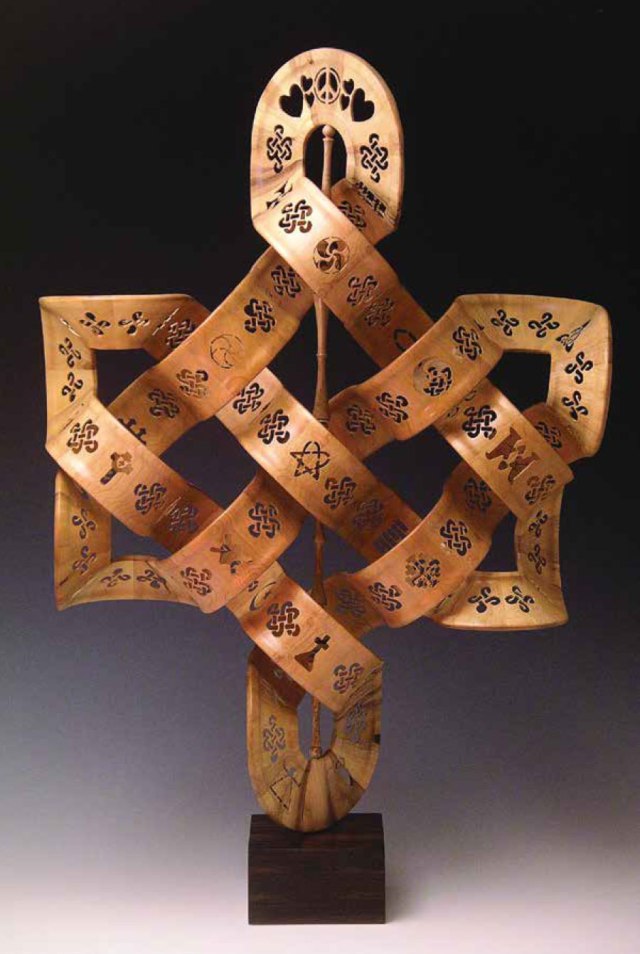
This is an excerpt from “The Difference Makers” by Marc Adams.
One of the people who had the greatest impact on Malcolm was his grandfather, Rap Gardner. At an early age, Granddad would give him guidance on how to make items with wood. He still remembers making a birdhouse before he started grammar school. From those early days Malcolm always had an interest in woodworking. It wasn’t until after he got married that woodworking became a necessary hobby. In 1976, after scraping together enough money with his wife, Tere, to buy their first home, there was nothing left for furniture. He purchased a Craftsman table saw and converted a bedroom into a shop (there was no garage) and proceeded to make their furniture, some of which is in use today.
In 1993, Malcolm had a shop full of tools and a house full of furniture, so his desire to stay active in the shop turned to woodturning. For the first year, Malcolm turned in isolation. He knew nothing about woodturning clubs, the American Association of Woodturners (AAW) or the fact that there were schools scattered throughout America that offered workshops on turning methods. Turning bowls was a great place to start, with instant gratification, but after turning a few dozen bowls, he found life at the lathe became boring. He started gluing in a few pieces of wood to add some character and color, not really knowing that he was creating “segmented” turnings.

In 1994, Malcolm discovered there was to be an AAW woodturning symposium in Fort Collins, Col. Because he had the time and the resources he decided to attend and took along a few of his pieces to display in the open gallery. He was so new to turning that he had no idea who any of the presenters were but ended up in a workshop on deep vessel hollow forms taught by Clay Foster. This was his first exposure to professional turning – the first time that he witnessed another person turn wood. By the end of the weekend he befriended a gentleman by the name of Ray Allen, one of the world’s best-known segmenters. Ray was an inspiration to Malcolm and his first real turning mentor. Ray’s work as a segmented turner elevated the craft to an acceptable form of art turning, and it boosted segmented turnings to the collector level. Prior to Ray, segmented turning didn’t have a great reputation due to so many gluing failures and improper construction methods. However, Malcolm saw segmented turning as a truly unique art form that was in its infancy. He was hooked.

Malcolm then discovered an AAW turning chapter in Sacramento and religiously made the two-hour trip to meetings every month for years. He became driven to learn all he could about turning while creating and developing new processes in his segmented works. By 1997, he became a regular instructor at the annual AAW symposium and eventually became a board member and even the vice president. Although he didn’t become a full-time professional turner until after he retired from the ski industry in 2002, his work was represented at a gallery in San Francisco called the Stones Gallery. Within eight short years Malcolm had gone from a turning beginner to a turner extraordinaire.
During the last three decades Malcolm has developed many innovations such as the porthole feature ring, ribbon construction, dizzy bowls, checkered hollow forms, tubular construction and orderly tangles. His work ranges from tiny jewelry items to outdoor sculptural pieces that require a crane for installation. He, along with Bill Smith and Curt Theobald, are the founding fathers of the Segmented Woodturners, an AAW chapter with hundreds of members around the world that host a biennial symposium. He has written three books, self-produced countless educational videos and has a big following on YouTube.

However, his greatest contribution to the world of polychromatic turning is much more than inventing new ways to glue together pieces of wood. Malcolm is responsible for crossing the line between fine woodworking and fine turning. Through intuition, remarkable engineering and clever designs he has transformed the process of cutting, gluing and assembling wood in contorted ways. Then, with the skills of a virtuoso turner, he has proven that the two crafts, woodworking and woodturning, can collide and live in harmony.
— Meghan B.